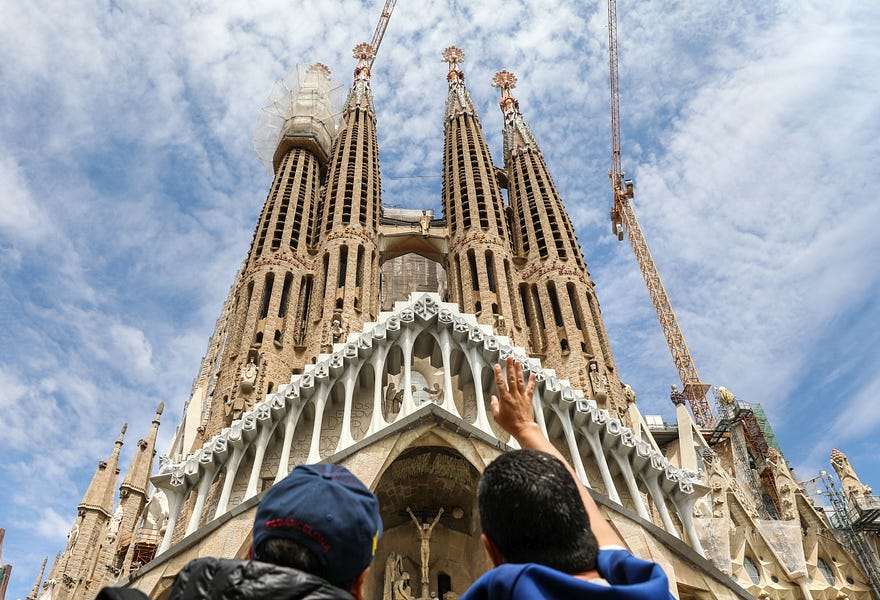Earlier this month, Tara Isabella Burton published a fascinating—and very familiar—essay in the New York Times called “Christianity Gets Weird.” She described a small but lively movement of mainly young Christians who are rediscovering the ancient church. They’re doing things that may just seem a little strange. Here’s Burton:
More and more young Christians, disillusioned by the political binaries, economic uncertainties and spiritual emptiness that have come to define modern America, are finding solace in a decidedly anti-modern vision of faith. As the coronavirus and the subsequent lockdowns throw the failures of the current social order into stark relief, old forms of religiosity offer a glimpse of the transcendent beyond the present.
She continues:
Weird Christianity is equal parts traditionalism and, well, punk: Christianity as transgressive alternative to contemporary secular capitalist culture. Like punk, Weird Christianity has its own, clearly defined aesthetic. Many Weird Christians across the denominational and political spectrum express fondness for older, more liturgically elaborate practices — like the Episcopal Rite I, a form of worship that draws on Elizabethan-era language, say, or the Latin Mass, or the wearing of veils to church.
In the piece she highlights “an Episcopalian seminarian who is using Google Hangouts to pray the Office of the Dead,” mentions “MechaBonald” (a “Weird Catholic online ecosystem”), and talks to Rod Dreher, the patron pundit of intentional, high-church counterculture.
As I read the piece, I immediately had two related thoughts. The first was about “cage-stage Calvinists” from my own religious tradition (or perhaps the “young, restless, and reformed”). The second was about Kierkegaard. “Weird Christianity” is hardly limited to the high church, and weird Christianity is often the beginning stage of meaningful reform. It often represents the revolt of Christianity against Christendom. But it’s not without its own profound perils.
What is a cage-stage Calvinist? It’s a person who’s recently discovered that the answer to “life, the universe, and everything” isn’t “42” but rather “TULIP.” Okay, maybe that’s a bit obscure—both from a science fiction and theological perspective. Not everyone is up to speed on the Hitchhiker’s Guide to the Galaxy and John Calvin’s Institutes of the Christian Religion, but a cage-stage Calvinist is a fresh convert to reformed theology who is very, very ready to tell you all about it—typically while sipping a carefully chosen craft beer that drips ever-so-slightly onto their full beard.
I bring up the cage-stage Calvinist to illustrate that there are countless branches of Weird Christianity, and the weirdness is defined by context. There’s the staid fundamentalist who lifts his hands in exuberant worship for the first time, the Catholic whose faith reignites during the Latin Mass, or the cessationist who prays for divine healing in a time of crisis.
The weirdness often has a common cause—the realization that there is something deeply wrong with the church’s institutions, culture, or doctrine.. So the Weird Christian seeks something different. They seek something real.
I’ve often thought of Kierkegaard’s Attack Upon Christendom. Forgive this too-brief and too-simple summary, but Kierkegaard perceived a conflict between Christianity—the faith—and Christendom, the institutionalized church. Kierkegaard was confronting an actual state church, but there is a facsimile of Christendom in American religion, found in the immensely powerful formal institutions of both American Catholicism and American Evangelicalism.
I’m most familiar with Evangelical Christendom, the network of Christian schools, churches, activists, publishers, and charities that employ people by the tens of thousands, exercise extraordinary influence over one of the two great political parties in the most powerful nation in the world, and create their own distinct culture and enforce their own distinct norms.
As I’ve argued before, a form of Christendom is necessary and important:
[But] that form should not be state-sanctioned Christianity, but rightly oriented private institutions that facilitate the spread of the Gospel and the compassionate works of the church. I’ll never forget the kind and loving Catholic social worker from Catholic Charities of Tennessee who helped my Calvinist family adopt an Ethiopian Orthodox child.
Moreover, rightly oriented institutions can impose the necessary theological and spiritual discipline that prevents churches from spinning off into apostasy and error. If a church proclaims that it is Southern Baptist or a member of the Presbyterian Church in America (my denomination), that has to mean something.
At the same time, the interests of any given institution are not symmetrical with the interests of the church, and reflexive institutional loyalty can lead to confusion, coercion, and error. The defense of your church or your school or your political movement is not the same as (and is sometimes in opposition to) the defense of the Christian faith.
When we study the causes of declining church attendance and faith in America, we repeatedly hear that the hypocrisy and corruption within Christian institutions alienate American hearts and minds. I’ve heard that critique my entire life. I get reader mail from people who are seeking a spiritual home after suffering dreadful abuse or witnessing infuriating misconduct.
It gets worse when people of faith justify hypocritical alliances, double standards, and even blind ambition by arguing that it “protects the church.” No, it protects Christendom, and there are times, sadly, when Christianity retreats even within the heart of Christendom itself.
All too often, we Christians are reflexively defensive of the institutions of Christendom. “We’re defamed in the media,” we declare. “Our critics are simply hostile to the Gospel,” we respond. And there’s a kernel of truth in those defenses. There is a level of unwarranted media hostility against the church. There are people who would fundamentally oppose the church even if it lived up to its ideals. They don’t believe its orthodox teachings. They may even believe church doctrine is heartless and cruel.
At the same time, who can honestly survey the state of American Christianity and declare “All is well”? Christendom—chock-full of sinful, fallen men and women—is always going to contain corruption. It is always going to mix virtue and vice. The wheat and the tares grow up together, and sometimes the tares can seem to choke out the wheat.
Enter Weird Christianity.
There are those Christians in every generation who ask questions. They’re the ones who challenge Christendom. Rather than reject the faith, they seek deeper understanding. In many ways, they’re essential to revival and revitalization.
But there’s a danger. In an outstanding essay in Mere Orthodoxy, Jake Meador described how Weird Christianity can quickly slide from critique or quest to affectation:
Inherent in the nature of American consumerism is the ability to ingest, assimilate, and spit out even its most strident critics. Anything can be made into a brand and perhaps nothing can be more easily branded than the anti-brand faux-rebelliousness of recent punk culture. If Weird Christianity is to make good on its missionary promise, then it will need to avoid the obvious danger of becoming the Hot Topic to Willow Creek’s Old Navy or Boomer Catholicism’s Land’s End, all of which are welcome at American capitalism’s table.
In a shout-out to the classic movie This Is Spinal Tap, at its worst, Weird Christianity can quickly become cricket-bat Christianity:
The quirks become the point. The weirdness is the marker, not the faith. Live long enough in Christendom, and you’ve seen it happen time and time again. As Meador notes, critique becomes fashion, and fashions always fade.
At its best, however, Weird Christianity can remind us that Christianity is, in fact, weird. It’s a counterintuitive faith that creates an upside-down kingdom:
“For whoever would save his life will lose it, but whoever loses his life for my sake will find it.”
“So the last will be first, and the first last.”
“For the wisdom of this world is folly with God.”
And the fruits of that counterintuitive faith and upside-down kingdom are decidedly countercultural:
“Religion that God our Father accepts as pure and faultless is this: to look after orphans and widows in their distress and to keep oneself from being polluted by the world.”
“[T]he fruit of the Spirit is love, joy, peace, patience, kindness, goodness, faithfulness, gentleness, self-control; against such things there is no law.”
“But I say to you, Love your enemies and pray for those who persecute you.”
Think of the people you know who best embody those values. Are they not always at least a little bit weird? And by weird, I don’t mean “quirky.” I mean countercultural. I mean self-denying. The most faithful people I know are forever doing strange things.
It’s weird to forsake your own comfort and constantly open your home to people in distress. It’s odd to give up a prosperous career to provide free medical care to the poorest people in the world. It’s bizarre when a person risks his life to speak the truth. It’s astonishing to watch someone actually love their enemies. Forgiveness instead of vengeance? It’s shocking to see:
What is the value of Weird Christianity? It can help shake us out of our slumber. It can stand against Christendom when Christendom conforms to the world. What’s the danger of Weird Christianity? That it becomes more weird than Christian. The quirks become the movement. The quest isn’t to be weirdly Christian but rather merely Christian, and mere Christianity is more than weird enough.
One last thing …
Let’s go with two final songs today. This one—another anthem from the lockdown—has moved me all week. Yes, it’s a bit sappy. But sometimes sappy is good:
Also, the song above made me realize that this newsletter has contained entirely too little Kirk Franklin. So here he is again, with one of my favorite songs:
Photograph of the Sagrada Familia Basilica by Valery Sharifulin/TASS/Getty Images.







Please note that we at The Dispatch hold ourselves, our work, and our commenters to a higher standard than other places on the internet. We welcome comments that foster genuine debate or discussion—including comments critical of us or our work—but responses that include ad hominem attacks on fellow Dispatch members or are intended to stoke fear and anger may be moderated.
With your membership, you only have the ability to comment on The Morning Dispatch articles. Consider upgrading to join the conversation everywhere.